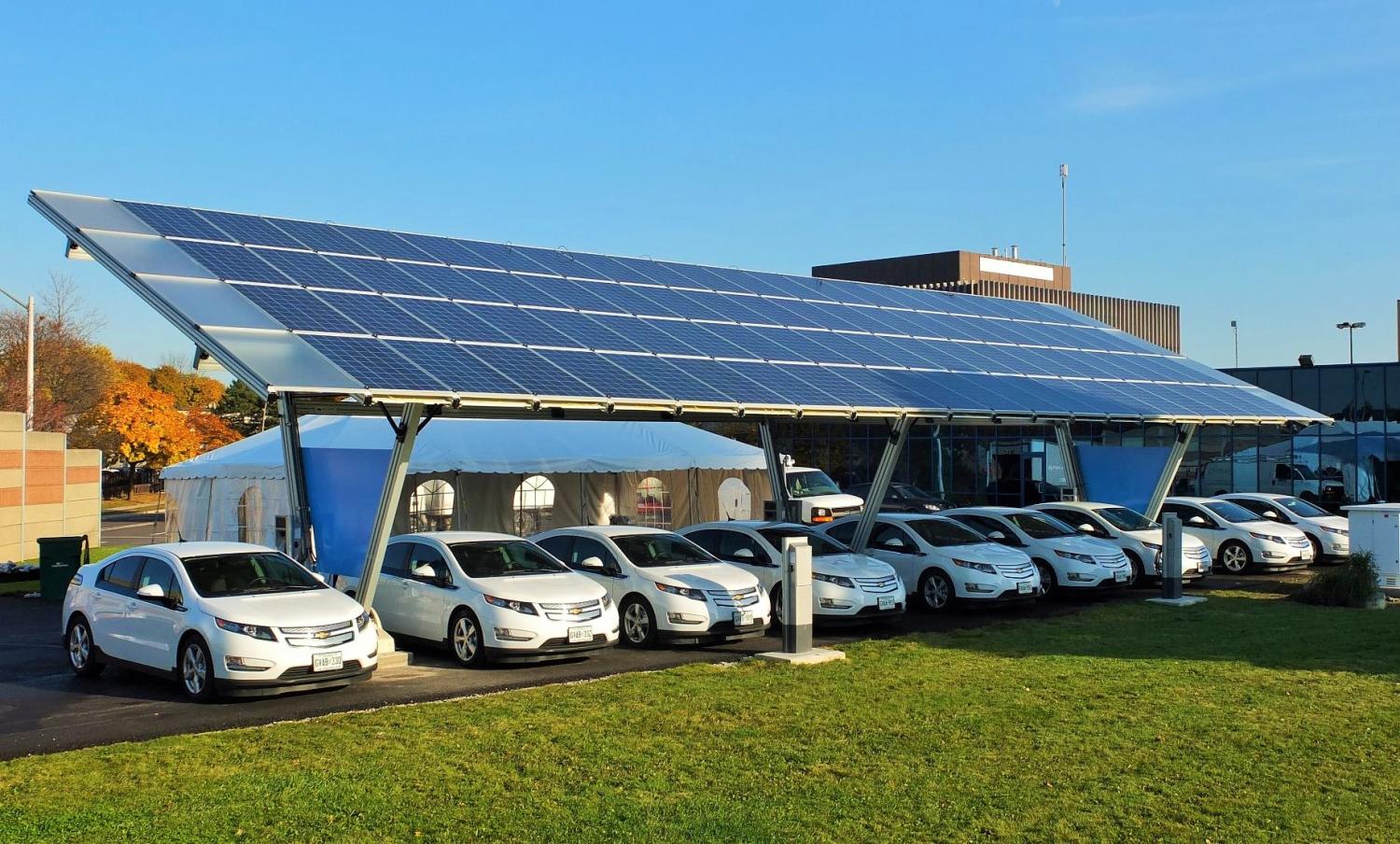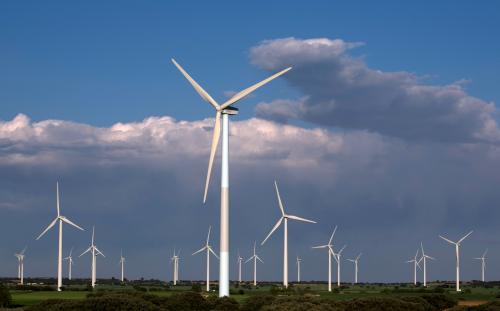President Trump has stressed the importance of oil and “clean” coal in America’s economic growth, and meanwhile a wide range of emerging clean technologies—ranging from renewables and energy storage to nuclear power—also have tremendous potential.
However, igniting an energy boom is going to require lots of innovation, which will in turn require more than just the stepped-up inventions and patenting we discussed a few weeks ago. Rejuvenating energy innovation will also require ensuring the availability of plentiful capital to help commercialize breakthrough “cleantech,” whether these innovations are in the form of hyper-efficient solar modules, new kinds of batteries, or cheaper and safer nuclear.
And yet today, the nation faces a significant crisis in cleantech innovation. Not only has cleantech patenting slowed down, but there are indications that the early-stage financing system critical to helping innovative new energy companies grow is not working well either.
In fact, a close look at one crucial type of growth finance for cleantech companies—venture capital (VC) investment—suggests that early-stage cleantech companies and entrepreneurs are facing increasing challenges in accessing investment and VC dollars.
In view of that, this analysis looks at VC investment data across 15 cleantech categories during the 2000s, with a particular focus on years since 2011, and on the nation’s diverse metropolitan areas. What do we find? The analysis provides new evidence that cleantech VC activity is changing in ways that are requiring new commercialization strategies. Along with a significant drop in VC investment in cleantech, investments have concentrated in a few technology areas, in more mature firms, and in just a few metropolitan areas, raising concerns about the narrow and spotty focus of cleantech VC. The upshot: New and more diverse approaches to finding and funding America’s new great cleantech companies are sorely needed.
Venture capital in cleantech
VC investment—private equity provided by firms or funds to small, early-stage, companies considered to have strong growth potential—has played an important role in accelerating the commercialization of game-changing new energy technologies and boosting the competitiveness of the United States in the global economy.
A distinctive feature of VC, unlike other forms of external finance, is that it facilitates the provision of funding to high-potential startups with highly innovative ideas that face substantial technology risk.1 With limited internal cash flow to draw upon and limited access to debt finance, innovative startups in the energy production, energy efficiency, transportation, and energy storage realms often depend critically on VC funding to grow their businesses and diffuse their technologies.2
Such funding has been essential to the growth of well-known cleantech firms, including Boston Power, Nest, Silver Spring Networks, and Solar City (now absorbed into Tesla) in the energy storage, smart grid, and solar industries.
Hence the present assessment: Based on data from the Cleantech Group, this post looks at VC investment in cleantech in multiple industries at the metropolitan level in order to assess how it has changed over the years and what these changes mean for the cleantech sector going forward.3Similar to our earlier brief on cleantech patenting, this analysis looks at technologies and services across a number of industries that minimize natural resource use or pollution, including advanced green materials, air, bioenergy, conventional fuels, energy efficiency, energy storage, geothermal, hydro and marine power, nuclear, recycling and waste, smart grid, solar, transportation, water and wastewater, and wind.4 Finally, for purposes of this research, VC investment is analyzed across the early stage, comprising seed and “series A” rounds, and later stages, comprising “series B” and growth equity rounds.5
Findings: Declining funds, more narrowly distributed
Four major findings stand out from our assessment:
1. U.S. cleantech venture capital investment has declined sharply since 2011
Between 2011 and 2016, VC cleantech investment declined by nearly 30 percent, from $7.5 billion to $5.24 billion. In addition to a lower total amount invested, the number of deals fell from 649 in 2011 to 455 in 2016. The average deal sizes are smaller, too.6
Another way to assess cleantech VC performance is to look at cleantech VC investment’s share of total VC investment. Here, too, the data are troubling. U.S. cleantech VC investment as a share of total VC investment plummeted from 16.8 percent in 2011 to 7.6 percent in 2016. Software, on the other hand, significantly increased its draw of VC dollars, from 31.8 percent to 47.7 percent, while the pharmaceutical and biotech sector had a more modest gain, 9.5 percent to 11.3 percent.7
Cleantech has historically been a hot and cold area for VC investors, with the sector experiencing booms and busts over the years. After a relatively small beginning in 2001-2004, VC funds started plowing billions into cleantech start-ups with visions of disrupting the energy industry and cutting carbon emissions. In 2001, VC investment in cleantech stood at just $365 million across 59 deals. By 2008, two years after the release of Al Gore’s movie “An Inconvenient Truth,” VC investments in cleantech had reached $6.65 billion across 385 deals—an annual average growth rate of 51.4 percent over that period.
However, the financial collapse in 2008 erased much of the gain made by the sector and the VC climate began to cool—venture investments in cleantech fell from $6.65 billion in 2008 to $4.16 billion in 2009.
Then, in 2010, the sector rebounded and funding into VC-backed cleantech companies reached a peak in 2011, with 649 deals attracting $7.5 billion.8Thereafter, several factors—including the struggles and failures of some heavily VC-funded companies (Solyndra and Evergreen Solar, to name a few); the onset of cheap natural gas, which makes solar and wind projects less economical; and the commoditization of solar modules, which makes VCs less willing to invest in solar manufacturing innovation—have caused investors to lose confidence in the sector and rein in investment.
2. Cleantech VC investment is disproportionately concentrated in a few metro areas, with just four metros accounting for more than half of all such investment
The economic health of the national economy depends on broadly distributed vibrancy that emanates from regions all across the country. In this regard, VC investment is the fuel powering America’s innovation economy, propelling dynamic, high-growth companies, and at the same time contributing to local economic growth.9 And yet VC investment remains extremely concentrated in a handful of places, leaving other regions of the country starved for participation.
Specifically, U.S. cleantech VC investment is heavily clustered in just four metro areas—San Francisco, San Jose, Boston, and Los Angeles, which account for a massive 54 percent of all VC flows in cleantech. Since 2011, San Francisco has led all other metros in both total dollars and number of deals, with $8 billion—accounting for 24 percent of cleantech VC investment between 2011 and 2016—invested across 585 deals. San Jose takes second place with $5.1 billion, or 15 percent of the total. Boston and Los Angeles metro areas follow, accounting for 9 percent and 7 percent, respectively. Houston, San Diego, Austin, New York, Washington, and Chicago round out the top 10 metros. Collectively these 10 metro areas have attracted 74 percent of cleantech VC funding since 2011.
Table 1: 10 large metro areas have cornered 74 percent of cleantech VC investment since 2011 (2011 – 2016)
| Metropolitan areas | Total metro cleantech VC investment | Metro share of total cleantech VC investment | Cleantech VC per capita |
| San Francisco-Oakland-Hayward, CA | $7,979,475,330 | 23.6% | $1,761.9 |
| San Jose-Sunnyvale-Santa Clara, CA | $5,104,279,027 | 15.1% | $2,650.6 |
| Boston-Cambridge-Newton, MA-NH | $2,938,024,856 | 8.7% | $625.8 |
| Los Angeles-Long Beach-Anaheim, CA | $2,263,256,516 | 6.7% | $172.1 |
| Houston-The Woodlands-Sugar Land, TX | $1,927,137,243 | 5.7% | $303.6 |
| San Diego-Carlsbad, CA | $1,284,435,994 | 3.8% | $398.5 |
| Austin-Round Rock, TX | $1,025,868,054 | 3.0% | $543.0 |
| New York-Newark-Jersey City, NY-NJ-PA | $1,005,261,776 | 3.0% | $50.3 |
| Washington-Arlington-Alexandria, DC-VA-MD-WV | $770,419,922 | 2.3% | $129.5 |
| Chicago-Naperville-Elgin, IL-IN-WI | $613,924,466 | 1.8% | $64.4 |
Source: Brookings analysis of Cleantech Group’s i3 Connect database.
Since large places may attract more VC investment simply because of their bigger populations and large economies, we also tracked VC funding on a per capita basis. San Francisco and San Jose again top the list, this time in reverse order. However, a number of smaller metropolitan areas, such as Boulder, Colo.; Santa Maria-Santa Barbara, Calif.; Santa Rosa, Calif.; and Durham, N.C., move way up the list of significant VC destinations. So while VC investment is clearly clustered, it is also true that smaller places—especially those surrounding research universities—can generate significant startup activity and attract considerable VC investment for their size.

The top 10 metros also exhibit different profiles in terms of attracting cleantech VC dollars. Houston, as the nation’s energy capital, has attracted the lion’s share (29 percent) of VC funding in the conventional fuels category from 2001 to 2016. The bioenergy sector is a key strength of San Diego’s regional cleantech industry, with nearly 11 percent of VC funding of bioenergy going to San Diego startups like Sapphire Energy, Verdezyne, and Synthetic Genomics. In a similar fashion, Chicago’s bioenergy startups have cornered more than 60 percent of cleantech VC funding going into the region and 10 percent of funding going into the bioenergy sector. Boston—home to a number of innovative energy storage companies such as VIONX Energy and Ambri—cornered 16.7 percent of VC funding going into energy storage during the 15-year period. Energy efficiency startups located in San Jose attracted a quarter of VC funding going into the energy efficiency sector between 2001 and 2016. Finally, a third of San Francisco’s cleantech VC dollars have gone to its solar sector.
3. Cleantech VC investment is biased toward late-stage deals and a few technology areas, with energy efficiency, solar, and transportation attracting more than half of the funding
In addition to an extreme geographic concentration in a few big metros, the trend in cleantech VC investment reveals two other areas of concern: Early-stage startups across all cleantech categories are getting less funding, and VC dollars for startups trying to create radically better energy technologies for combating climate change are declining.
In 2016, 87 percent of total cleantech VC dollars went to more mature companies that were near or at profitability—what is characterized as late-stage investment (Series B and growth equity rounds). The amount invested into seed and Series A—together comprising early-stage financing—has dropped sharply from over 32 percent in 2001 to 13 percent in 2016. The move away from early-stage cleantech VC financing is most visible in the post 2008 years. Since then more than 80 percent of cleantech VC dollars every year have gone to late-stage companies.

The problem with this is that early-stage startups have to work harder to obtain funding, meaning that fewer novel and potentially game-changing technologies are getting past the early stage. If the trend continues, breakthrough and game-changing technologies will be underfunded, and the ability of the U.S. economy to break free from the domination of fossil fuels in the next 25-50 years will be reduced.10
Furthermore, cleantech VC dollars are concentrated in just a few technology areas. Smart grid and energy efficiency technologies have made up nearly a quarter of venture capital financing since 2011. Two other technology areas, transportation and solar, accounted for 21 percent and 16 percent, respectively. Together with bioenergy (10 percent) and energy storage (8 percent), those five sectors accounted for nearly 80 percent of total cleantech VC funding and 62 percent of deals.

These and other trends reflect that VC investors have become extremely wary of any technology that would take a decade or hundreds of millions of dollars to commercialize. That explains why such a high share of cleantech VC dollars has been going to energy efficiency and transportation (especially ride-sharing/vehicle-sharing companies, fleet-tracking apps, transportation software, and, more recently, autonomous vehicles)—areas that have technology foundations closely related to the traditional software-based areas of VC investment. These technologies are less capital intensive than other clean energy technologies, have a shorter time horizon, can be applied to a wider range of energy products and services, and are less reliant on government incentives or subsidies that may be withdrawn. Even in the solar sector, more VC money now goes to solar finance and installation companies such as SolarCity, SunPower, Sunrun, SunEdison, and Sungevity, instead of to solar startups such as First Solar and now-defunt Solyndra, which have focused on manufacturing better solar panels.
The implication is that VCs have all but stopped funding “deep technology” companies, whose work is necessary to avoiding the worst effects of climate change. Take the case of nuclear, where VC funding remains extremely weak. Nuclear first attracted VC funding in 2007, when Tri Alpha Energy raised $40 million for its nuclear fusion technology. Since then nuclear deals have been stuck in the single digits. In a similar fashion, VCs are reluctant to fund high-risk, capital-intensive ventures like offshore wind farms, biofuel refineries, and unproven solar cell technologies. Last year less than one percent of cleantech VC dollars reached wind and about eight percent landed in bioenergy—a particularly capital-intensive slice of cleantech.
4. Corporations and corporate VCs are filling in some of the gap left by traditional VC, but it may not be enough
As VC funding in the cleantech space has slowed in the last few years, with many VCs and late-stage financiers reining in investment, corporate investment is partly picking up the slack. Some corporations like General Electric, Google, and Duke Energy are directly investing money into startups, with an eye toward acquisition down the road. An increasing number of companies are also establishing corporate VC funds, including GE Ventures, BMW i Ventures, and Chevron Technology Ventures, that operate like traditional VCs investing in next-generation technology.
In 2016, 102 deals had at least one corporation or corporate VC involvement, compared to 144 deals in 2011. However, the share of corporate involvement in startup funding has remained steady since 2011, with 22 percent of total deals in both 2011 and 2016 attracting corporate funding. While the trend of corporate investment cuts across several cleantech sectors, from advanced green materials to solar, corporate funding is geared toward the transportation and energy efficiency sectors. In 2016, corporations, including their VC arms, invested in 23 energy efficiency and 26 transportation startups, accounting for 23 percent and 26 percent, respectively, of deals that had corporate backing.

While corporate investors have helped fill the funding needs of startups, their interest in “capital-efficient” energy efficiency and transportation sector startups appears to mirror traditional VC interest in these sectors. For instance, with new automakers like Tesla and tech giants like Google and Apple eyeing autonomous vehicles and developing the car as a new software platform, traditional car manufacturers have set up venture arms and are betting on startups focused on car development and battery technology. BMW i Ventures recently moved its headquarters from New York to Palo Alto, Calif., to be closer to startups shaping the future of transportation.11
At the same time, the role of large corporations in sparking fundamental innovation should not be overestimated. These companies, with legacy businesses to protect and sustain, are unlikely to expand their involvement and pick up more of the slack in funding disruptive clean technologies.12
Defending progress
There is no doubt that VC investment has played a critical role in the takeoff of the cleantech sector. In his article, “Cleantech Venture Capital: Why Are These Investors Smiling?,” Eric Wesoff provides numerous examples of successful VC-backed companies that became public, generated substantial returns for their investors, and have become heavyweights in certain cleantech segments like solar (think SolarCity, Sunrun, Sunnova, and Vivint Solar) and electric vehicles (Tesla).13
However, as this analysis reveals, VC money has not been reaching many promising technologies, especially the riskiest ones, often with the heaviest financial demands, that are urgently required to address climate change. At the same time, the highly disproportionate concentration of cleantech VC investment in a handful of metro locations may be excessively narrowing the sector while complicating the challenges startups in the rest of the country face in raising capital.
These findings are in line with a growing body of evidence that suggests that the traditional VC model may be ill-suited for many cleantech sectors. A report from the Massachusetts Institute of Technology (MIT) Energy Initiative found that cleantech companies lagged far behind their counterparts in software or medical technology; the $25 billion spent on cleantech between 2006 and 2011 resulted in investors losing more than half their money. Overall, 150 Silicon Valley cleantech startups from those years failed—or failed to thrive.14 Other research in recent years has also warned that many VC investors dove into cleantech hoping for quick returns but have had little understanding of the sector.15
Against this backdrop, new models of financing that are aligned with the nature and needs of the cleantech sector are sorely needed. To be sure, serious money is still flowing into cleantech, and the most successful VC investors have been adapting their investment strategies to accommodate the sector’s peculiarities.16 So the private sector may be responding. Yet there remains immense scope for new types of investment vehicles that deploy patient risk capital over a longer time horizon. In all this, the role of the public sector, especially the federal government, cannot be minimized. Adequate public funding into early-stage cleantech R&D, as our previous brief on cleantech patenting showed, and commercialization activities will be necessary going forward. But so will smart new partnerships between government and industry.
The role of the federal government
Cleantech’s future under the Trump administration appears uncertain. The Trump administration’s policies and its appointments to energy leadership positions reflect a significant shift away from those of the Obama administration, which focused on the advancement of renewable energy sources, support for the development and deployment of clean technologies, and a commitment to doubling clean energy R&D by 2020 as part of Mission Innovation.17
President Trump’s proposed “skinny budget,” by contrast, introduces significant uncertainty, by proposing the elimination of many federal clean energy programs, including the Advanced Research Projects Agency-Energy (ARPA-E) and the U.S. Department of Energy (DoE) loan guarantee program (LGP), which support technologies too risky for bank financing. ARPA-E has provided critical seed money, usually up to a couple of million dollars, to more than 500 projects in diverse technologies including solar, wind, natural gas, fusion, bio-engineered fuels, and batteries.18 The loan guarantee program, which functions much like a VC investor by investing in promising ideas, has approved 30 guarantees that have helped commercialize diverse technologies such as solar thermal systems, advanced nuclear designs, molten salt storage, and automotive technologies.19 These and similar other programs are under threat.
Instead of radically reducing or eliminating an array of cleantech programs, the federal government needs to continue to support programs like ARPA-E and the LGP that can increase the odds of survival of early-stage business ideas into commercialization. In this regard, ARPA-E, which enjoys bipartisan support, should be maintained and expanded. Similarly, DoE’s loan guarantee program, which still has $41 billion in existing spending authority, should be used to fund a variety of innovative energy and infrastructure projects.20Furthermore, a variety of new efforts aimed at increasing the prospects for successful development and commercialization of breakthrough energy technologies have emerged in recent years, often through DoE’s national laboratories.21A wide array of national lab “technology-to-market” programs, for instance, are helping to increase the labs’ participation in commercialization, entrepreneurship, and local innovation ecosystems. One of these initiatives, Cyclotron Road, at Lawrence Berkeley National Laboratory, addresses the gap between early-stage energy technology invention and high-impact commercial outcomes by providing a home for entrepreneurs to advance and commercialize technologies.22Informed by analysis of the challenges startups and other private firms face in advancing their ideas toward commercialization, these programs provide the private sector with access to the technical leadership and expertise residing in national labs and leading research institutions, business/product verification, flexible financing, and commercial validation.23 In doing so, these programs can help firms scale up, become more productive, and improve the competitiveness of the energy industry whose growth President Trump has said is a central focus of his administration.
The role of states and localities
In the face of federal drift and inaction, meanwhile, state and local action to help increase the success rate for cleantech startups is becoming even more critical. In this regard, states and localities have the opportunity to implement locally focused clean energy investment and/or enterprise development funds that provide formal business development and investment support for local clean energy startups to address persistent funding gaps and increase business opportunities.24To be sure, many U.S. states, including California, Colorado, Massachusetts, and New York, are already leaders in investing in early-stage companies.25 In addition, a handful of states, including Connecticut, Hawaii, New York, and Rhode Island, have created state green banks—financial institutions that use public debt to mobilize new private sector investment in clean energy projects.26 Going forward, some of these institutions may want to expand their operations to finance innovative, riskier new technologies that cannot obtain low-cost capital from institutional investors and bond markets to finance commercialization at scale.27 Such state support for cleantech startups needs to spread to more states across the country, especially given that VC investment tends to concentrate in a few metro locations.
The role of the private sector
Beyond public support, finally, the cleantech sector needs to experiment in its own right with new finance models designed to bridge resource gaps. There is no doubt that corporations and corporate VCs are going to need to play a larger role in financing start-ups. This corporate role is already significant; it will need to expand, at a moment when many companies are sitting on large cash piles and say they are looking to spur innovation. Meanwhile, a few new developments justify optimism. In this regard, a new set of investors with a long-term commitment to new technologies and a willingness to put patient risk capital to work have arrived on the scene. Most notably, Bill Gates and other top investors—part of the Breakthrough Energy Coalition—recently launched a $1 billion Breakthrough Energy Ventures fund that will put money into cleantech companies over the next 20 years.28 In addition, a new set of “super-connectors” have emerged to connect promising startups with other funding sources like family foundations and large institutional investors.29 Finally, incubators like Los Angeles-based LACI and Boston-based Greentown Labs, often supported and funded by state agencies, are part of a new wave of organizations geared toward efforts to help startups access strategic partners and investors to effectively scale their businesses. The emergence of these newer types of models in the financial industry—with their longer time horizon, incentive structures, and mission-based investment strategies—highlight their potential to offer a steady stream of committed investment capital to the cleantech sector.
Summing up
In the end, innovation in the U.S. cleantech space will depend critically on the ability of the VC investment community to adjust to the particular characteristics of the sector.
Looking forward, commercializing new, innovative clean technologies to grow the economy and slow climate change will require a more diverse set of actors and funding models that leverage new private and public funding sources to spur the next generation of breakout clean energy companies.
-
Footnotes
- Shikhar Ghosh and Ramana Nanda, “Venture Capital Investment in the Clean Energy Sector,” Harvard Business School Working Paper 11-020 (2010).
- Alfred Marcus, Joel Malen, and Shmuel Ellis, “The Promise and Pitfalls of Venture Capital as an Asset Class for Clean Energy Investment,” Organization and Environment 26, no. 1 (2013).
- Data on cleantech VC investment were obtained from the Cleantech Group’s i3 Connect database. Venture capital investment in the cleantech sector is a relatively new phenomenon that emerged toward the end of the 1990s. Following the dot.com bubble burst in 2001, VC investors were looking for alternate sectors to invest their funds in and started paying attention to cleantech companies. Therefore, this brief covers data going as far back as 2001 to understand the longer-term trends in this sector.
- In contrast to the previous Brookings paper on cleantech patenting, which focused on 14 cleantech categories, the present analysis adds smart grid as a separate category due to significant investment in smart meters, meter data management apps, and, more recently, Internet of Things (loT) devices.
- Deals that were above $350 million were excluded from the analysis since such big VC investment amounts are less likely to be geared toward innovation and more toward market growth and expansion by the company. In the cleantech database, deals above $350 million are mainly to be found in the transportation sector, for ride-sharing/car-sharing companies like Lyft and Uber. After applying the various filters described above, the Brookings cleantech database had 6,106 VC deals from 2001 to 2016. For more information, see https://i3connect.com/.
- Over a longer-term period, however, the cleantech sector’s performance has fared better. Between 2001 and 2016, VCs invested a total of $61 billion into some 2,533 cleantech companies. This capital was dispersed in a total of 6,106 deals. During this period, the cleantech sector grew at an average annual growth rate of 19.4 percent (in investment dollars).
- Data on total VC investment and those for software and pharma & biotech have been obtained from PitchBook. PitchBook analysis breaks down VC investment into the following categories: software, pharma & biotech, media, information technology hardware, healthcare services & systems, healthcare devices & supplies, energy, consumers goods & recreation, commercial services, and others. See PitchBook, “4Q 2016 PitchBook-NVCA Venture Monitor,” January 11, 2017.
- This confidence in the sector was in large part due to government support to clean energy and other clean technologies through the 2009 American Recovery and Reinvestment Act and U.S. loan guarantees for companies operating in these areas.
- Richard Florida, “A Closer Look at the Geography of Venture Capital in the U.S.,” CityLab, February 23, 2016. See also Emily Liner and Ryan Bhandari, “America’s Got Talent—Venture Capital Needs to Find It” (Washington: Third Way, 2017).
- Marcus, Malen, and Ellis 2013.
- Jaclyn Trop, “BMW’s Venture Capital Arm Is Moving to Silicon Valley and Looking for Startups,” Forbes, November 28, 2016. As our data show, Silicon Valley (San Francisco and San Jose metro areas combined) draws the lion’s share of VC investment going into the transportation sector. It is not surprising that BMW is moving closer to the startups located in Silicon Valley.
- Marcus, Malen, and Ellis 2013.
- Eric Wesoff, “Cleantech Venture Capital: Why Are These Investors Smiling?” Greentech Media, January 5, 2015.
- Benjamin Gaddy, Varun Sivaram, and Francis O’Sullivan, “Venture Capital and Cleantech: The Wrong Model for Clean Energy Innovation” (Cambridge, Mass.: MIT Energy Initiative, 2016).
- These reports have identified a range of factors about the cleantech sector that makes it much more challenging from an investment standpoint than the typical investments made by VC investors: cleantech is more capital intensive, faces greater technology and regulatory risks, has long development cycles, suffers from geographical constraints that impact scalability, and has no established exit mechanism. In short, the market conditions and technological constraints of the cleantech sector fall far short of meeting the criteria for successful VC investing. For more details, see Ghosh and Nanda 2010. See also Andrew Hargadon and Martin Kenney, “Venture Capital and Clean Technology: Opportunities and Difficulties,” University of California, Berkeley Working Paper (2011); UNEP SEFI Public Finance Alliance, “Venture Capital as a Clean Energy Financing Tool With Specific Analysis on the Role of Public Sector-Sponsored Venture Capital” (Basel, Switzerland: SEF Alliance, 2014); and Eric Knight, “Five Perspectives on an Emerging Market: Challenges With Cleantech Private Equity,” Center for Climate Economics & Policy Working Paper 1110 (2011).
- The cleantech sector itself is evolving and attracting VC attention. For instance, many cleantech companies have huge capital costs including for installing expensive equipment. Founders do not want to give up a huge equity stake to investors in order to cover those initial costs. Instead, technology investors like Black Coral has done deals that are essentially a mixture of equity and debt financing. For more details, see Jeff Engel, “Cleantech Evolves, But Will Investors Follow?” Xconomy, January 19, 2016.
- This is evidenced by statements made by President Trump and his energy leadership appointees, specifically regarding exiting from or renegotiating the Paris Climate agreement, stopping implementation of the Clean Power Plan, reducing enforcement of environmental regulations or policies, and reducing the R&D budget.
- Since its launch in 2009, 74 of ARPA-E’s grantees have attracted $1.8 billion in private money, while 56 formed new companies. See Krysti Shallenberger, “ARPA-E 2017: Optimism Turns to Tension as Sector Prepares to Protect Energy R&D Funding,” UtilityDive, March 1, 2017.
- Brian Eckhouse and Eric Roston, “Trump Can’t Kill Solyndra Loan Office That Outperforms Banks,” Bloomberg, November 28, 2016.
- Dan Reicher, “$41 Billion in Guaranteed Infrastructure? DOE’s Loan Guarantee Program Is Ready,” The Avenue, March 2, 2017.
- Examples include the following: ARPA-E; Cyclotron Road, an early-stage energy incubation program out of Lawrence Berkeley National Laboratory; the Department of Energy’s Small Business Vouchers program, which helps small cleantech companies gain access to national lab technology consultation; the DoE’s Energy I-Corps, aimed at accelerating the transfer of clean energy technologies from national laboratories into the commercial marketplace; and also at DoE the Lab-Embedded Entrepreneurship Program and Chain Reaction Innovations at Argonne National Laboratory.
- See the Cyclotron Road website, http://www.cyclotronroad.org/.
- Richard Adams et al., “Accelerating Clean Energy Commercialization: A Strategic Partnership Approach” (Joint Institute for Strategic Energy Analysis, 2016),www.nrel.gov/docs/fy16osti/65374.pdf.
- Adams et al. 2016.
- Last year New York announced a $10 million investment to support new and existing incubators that will help early-stage and emerging clean energy companies across the state grow and succeed. The Massachusetts Clean Energy Center’s AccelerateMass program provides funding to Massachusetts-based startup companies that have graduated from business accelerator programs that focus on developing clean energy innovations. Moreover, MassVentures, a quasi-public corporation formed by the Commonwealth of Massachusetts, addresses the capital gap for startup companies and encourages the growth of early-stage technology firms. The California Clean Energy Fund has an entire suite of programs—such as CalSEED, New Energy Nexus, CalCEF Angel Fund, and Renewable Energy Trust Capital—designed to support the entire lifecycle of clean energy development, commercialization, and deployment. For more information, see the following websites: www.governor.ny.gov/news/governor-cuomo-announces-10-million-support-incubators-serving-new-and-emerging-clean; www.masscec.com/innovate-clean-energy/acceleratemass; http://www.mass-ventures.com/; www.calcef.org/.
- Mark Muro et al., “State Clean Energy Finance Banks: New Investment Facilities for Clean Energy Deployment” (Washington: Brookings Institution, 2012).
- The Connecticut green bank recently issued its first official “green bond” to provide financing to the New England Hydropower Company, which will be deploying a new hydro technology using the modern Archimedes Screw Turbine. In a similar fashion, the New York green bank issued a $5 million credit facility to New York-based startup Sealed that is pioneering a new finance model for residential efficiency—efficiency retrofits are paid back through a Sealed bill instead of through the traditional utility bill. For more details on both transactions, see PR Newswire, “New England Hydropower Energizes First Archimedes Screw Turbine Site in U.S.,” April 27, 2017; and Katherine Tweed, “New York Green Bank Funds a Startup Making Pay-As-You-Save Efficiency Upgrades,” Greentech Media, May 18, 2016.
- For more details, see the website of Breakthrough Energy at www.b-t.energy/ventures/.
- PRIME Coalition, for instance, identifies and vets promising early-stage companies and channels money from its member family foundations to those startups. In this manner, PRIME is facilitating the use of philanthropic funds in closing the funding gap for early-stage energy and climate-change technologies. Another “super-connector” is the Aligned Intermediary, an investment advisory group created to help large institutional investors—sovereign funds, pension funds, university endowments, insurance companies, and financial institutions—increase the flow of private capital into the cleantech sector.






